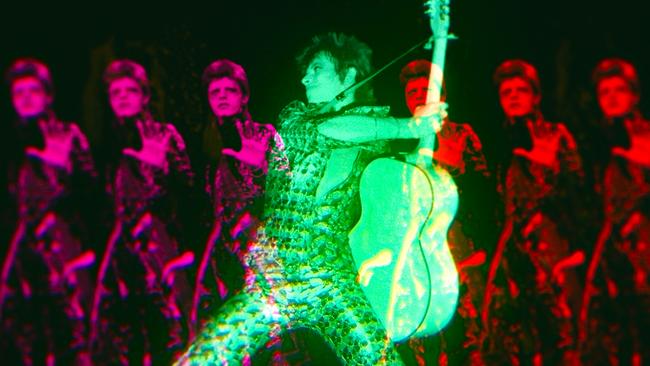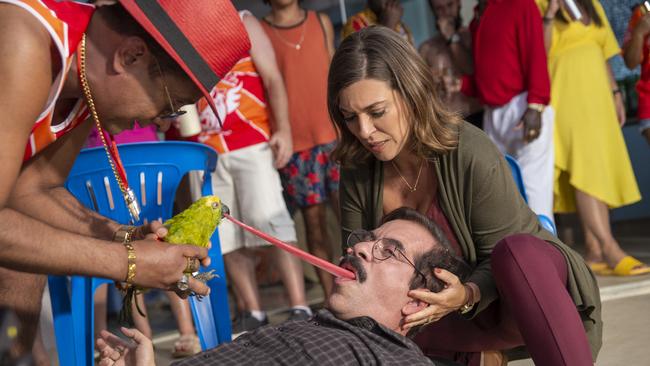Moonage Daydream, Bowie’s life in vivid colour
Moonage Daydream is not a cradle-to-grave life of the English singer-songwriter. Such a “safe” approach would, according to Bowie, mean the director was “not working in the right area”.

Moonage Daydream (M)
In cinemas from September 15
★★★★½
If David Bowie was an artist unlike any other, then Moonage Daydream lives up to its inspiration. This is an kaleidoscopically astonishing documentary, written and directed by Oscar-nominated American filmmaker Brett Morgen.
It is not a cradle-to-grave life of the English singer-songwriter, who died on January 10, 2016, aged 69. Such a “safe” approach would, according to Bowie, mean the director was “not working in the right area”.
Therefore this is how this 134-minute movie opens: with an on-screen quote reflecting on Friedrich Nietzsche’s views on the transience of life. “Does it matter? Do I bother?” Then it’s attributed: David Bowie, 2002.
We move to the moon in space and then to a lunar landscape. The first music we hear, briefly and softly in the background, is Inch Worm, the Danny Kaye song that Bowie covered.
Then a girl with a tail finds a skeleton in an astronaut suit. Then it’s Bowie before a crowd singing Hallo Spaceboy with the lines that might be an anthem for all that is to follow: “And I want to be free/ Don’t you want to be free?”
An explosion of colour; it’s the first scene of many that sent tingles through this viewer. I like Bowie’s music but I wouldn’t be sobbing if I missed seeing him, as the fans we see do. It’s the director’s unconventional presentation of an unconventional artist that is thrilling.
He shows Bowie’s life as a montage, so each moment on stage is spliced with other performances of the same song, clips from his films, images of his paintings, footage of his media interviews, videos of his time spent in Los Angeles, West Berlin and Japan.
It is so different – indeed almost hallucinogenic – that words tend to fall short in describing it. Except, fortunately, that the narrator is Bowie, via the media interviews and recordings from his personal archives, which also include previously unseen footage from his concerts and daily life.
The director was granted access to the archives, which also include photographs and journals, and the film is the first one about Bowie that is authorised by his estate.
In an astute move, he does follow a chronological timeline. The result is a fascinating insight into the ever curious, ever self-challenging mind of an artist of reinvention who preferred to step on thin ice. “From the age of 16,’’ he says, “I set myself in the general direction of uncharted waters.”
Yet at the same time there is the separation of introverted man and extroverted personas. He speaks of Ziggy Stardust, The Thin White Duke and even David Bowie in the third person. He was their canvas. It was not until his 30s that he performed as himself, or someone approximating himself.
The chronological timeline also shows us that Bowie, like any of us, can change his mind, can become wiser and kinder. When, in his 20s, he is asked about falling in love, he says “It can’t get in my way. I shelter myself from it.”
In an absolute highlight, for this viewer, we then move to Bowie singing Space Oddity, which has that beautiful but ambiguous line, “Tell my wife I love her very much/ She knows”.
In a later interview, Bowie says he dislikes his previous comments on love. He speaks of his adoration for his second wife, the model Iman, but their daughter is not mentioned.
Nor is his first wife, Angie Bowie, or their son, the film-director Duncan Jones (who uses his father’s real surname). Nor is Bowie’s drug use. His parents are noted only in the context of their “loveless” marriage.
This is a music documentary that does not mention record sales or show album covers. There are amazing scenes of Bowie performing but at its core this is a movie about one man’s complex mind and all its “extracurricular thoughts”, as he calls them.
His comments on art are fascinating. While he feels “humble” before someone like Titian, such work is not what he is looking for in art. He seeks art that finds the “grains of truth in the corners of the mind”.
The title is one of Bowie’s songs from the early 1970s. We do hear him singing it but, perhaps in keeping with the spirit of this project, we don’t see it as the title until the end credits. Nor are any of his film clips or media interviews identified.
If I could reverse time and see Bowie in the flesh I would choose not a concert but his performance as Joseph Merrick in The Elephant Man on Broadway in the early 80s. We see a snippet of that.
The Japanese director Nagisa Oshima saw the whole lot and it led him to cast Bowie in the 1983 prisoner-of-war film Merry Christmas Mr Lawrence, a performance for which I think he should have been Oscar nominated.
Moonage Daydream is Morgen’s third musical documentary, following Crossfire Hurricane (2012), about the Rolling Stones, and Kurt Cobain: Montage of Heck (2015). His Oscar nomination, alongside co-director Nanette Burnstein, was for the 1999 boxing documentary On the Ropes. On his new film he has said, “Bowie cannot be defined, he can be experienced”. Having seen this film, I can only agree and add what an extraordinary experience it is.
“Does it matter? Do I bother?” Bowie repeats that question towards the end and this time offers an answer. It’s one that’s worth listening to.
-
Fenced In (M)
Netflix
★★★½
Ever had neighbours you were glad to see the back of? If so you will welcome them back with open arms after watching the amusingly over-the-top Brazilian comedy Fenced In.
Forty-something Walter (Leandro Hassum) has a problem with noise. There’s a wacky opening scene where, in his day job at a musical instruments store, he looks after three nuns who turn out to be more into hell’s bells than devotional hymns.
He has a breakdown and ends up in hospital. His doctor warns that from now on “any noise could be fatal”.
With the diagnosis ringing in their ears, Walter and his wife Joana (Julia Rabello) flee Rio for a quiet life in the country.
At their new home they grow their own vegetables, eat eggs laid by their own chooks, drink wine (purchased, there are limits) and nod at elderly locals in matching tracksuits.
It’s an Arcadian idyll … until the next-door neighbours return home. That there’s a tuba in their car is but a small sign of what is to come.
Tony (Mauricio Manfrini) and Kelly (Marlei Cevada) run a samba school. Tony’s instrument is the drums and he runs 24/7 practice sessions around the pool. They also have a zoo in the backyard.
“Living here is like living next door to Disney World,” Walter says, “except Disney World has working hours.”
When he and Joana pop over to discuss the noise, Kelly answers the door. She wears a bright green bathing suit, multi-coloured sun hat, leggings and holds a fluffy white dog.
It’s just the start of the wardrobe changes, including for the dog, that make the costume department a star of the movie.
“That hurt in obscure places,” Walter whispers to his wife. Tony, in a bright red fedora, joins them.
He welcomes the new neighbours and adds that the previous occupant of their house killed himself. Why he did so, he adds, is a mystery. “He only left a cryptic note. ‘Silence at last’.”
This is a Portuguese-language movie (original title Vizinhos: Neighbours) so I relied on the English subtitles. I’m still laughing at lines like the “obscure places” one.
The scriptwriter is Paulo Cursino and the director is Roberto Santucci, who has had box-office success in Brazil after switching from thrillers to comedies.
With the quiet neighbours/noisy neighbours set-up, there’s some interesting live-and-let-live philosophical paths to be explored, and this 110-minute movie does so without ever forgetting it is first and foremost an entertainment.
There’s a lot of physical comedy, some of it involving a parrot, that made me think of Monty Python’s Flying Circus. It’s the sort of comedy that seems out of favour in Hollywood today and it makes this movie from South America a refreshingly frivolous change of pace.




